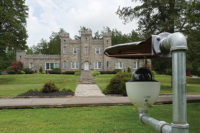Megapixel Cameras Boost Investigative Potential, Efficiency
When it comes to surveillance, megapixel is the word.

The installation of Avigilon 5 MP cameras throughout the fixed base operator (FBO) facility for Millennium Aviation has helped the company better safeguard its assets. Photo courtesy of Avigilon.

On first glance, the images from the surveillance camera show two people as a pair of pixels, dark specks on a gray streetscape. Hair color, eye color, facial expressions and more were not visible in the series of pictures taken from an airplane flying two miles above. But with megapixel surveillance the images can show things in much more detail and spread over a larger area.
When it comes to surveillance, megapixel is the word. Alhough megapixel cameras cost more than lower-resolution cameras and require more storage for the higher-resolution video, in specific situations it makes more sense to invest in megapixel technology.
According to Fredrik Nilsson of Axis Communications, there are three important criteria to consider:
- Do you need crystal clear detail for identification purposes – such as in a retail store, casino or bank?
- Do you need to cover long distances – such as a long hallway in a school or office complex?
- Do you have to cover a large expanse with few places to install a camera – such as a parking lot?
“Not so long ago, your choices were limited because megapixel cameras could only operate at low frame rates and performed poorly in low-light environments,” Nilsson says. “But with the advent of HDTV network cameras, where color fidelity and frame rate are guaranteed, HD/megapixel has become a versatile alternative to VGA cameras.”
Several situations show the benefits that megapixel can offer a security enterprise executive, including the Nebraska Medical Center, located in Omaha, that has a number of patients who require 24/7 observation. Until recently, the hospital would place a staff member in the room to keep an eye on the patient. This was standard practice for patients who, for example, were on suicide watch, prone to violent outbursts or in a critical state of health. It is typical for the medical center to have two or three dozen patients being watched in a one-on-one scenario on a given day, which put a strain on staffing costs and resources.
|
Want to Learn More? Check out the megapixel surveillance vendors featured in this article: |
To streamline its operations and improve care for at-risk patients, the center has deployed nearly 300 IQeye HD megapixel cameras to ensure patient safety, upgrade medical care and reduce staffing costs. There are a dozen monitoring stations located throughout the facilities, and each station allows one or two technicians to observe multiple patients simultaneously.
In Northeast Pennsylvania, Millennium Aviation is seeing the benefits of megapixel surveillance cameras in protecting its one million square-foot facility. With more than 30 corporate-owned or general aviation aircraft onsite, Millennium Aviation handles more than $100 million in assets at any given time. Millennium Aviation recently invested in an Avigilon high-definition surveillance system to monitor the entire site, including the airport ramp where aircraft are parked, loaded and boarded. The Avigilon high-definition surveillance system enhances image quality and system reliability and can capture the evidence we need to secure assets, safeguard passengers and protect from the threat of false liability claims. The megapixel cameras monitor the facility's fixed base operator (FBO) entrance, lobby, hangar, parking areas and fuel storage area. The surveillance system is integrated with the FBO’s access control system to monitor its vehicle entrance gate and remotely grant access when required.
Millennium Aviation has leveraged the advanced search functionality provided by the Avigilon Control Center software to expedite investigations and capture useable evidence. Another key selling feature of surveillance system is its high resolution image quality, which is central to the FBO’s ability to capture the detail necessary to confirm or deny aircraft damage and protect against costly false liability claims. By reducing the risk of false liability claims, Millennium Aviation has also been able to acquire insurance coverage from the highest-rated underwriters in the industry.
Megapixel Cameras Pass with Flying Colors at Texas School District
Mission Consolidated Independent School District (CISD) in the Rio Grande Valley of South Texas consists of roughly 41 square miles and serves almost 16,000 students in four high schools, four junior high schools, 14 elementary schools and two special needs schools.
For school districts across the country, video surveillance and security systems are no longer an option – they are must-haves. Mission CISD had an analog surveillance system in place, but found that its effectiveness was hampered by many limitations. First, the resolution of the images produced by the analog cameras was too low for identification. Next, after-the-fact forensic investigations were more difficult, if not impossible, to conduct due to the poor quality of the video that was captured. Finally, because the pan/tilt units were often facing the wrong direction at critical times, there was always a strong possibility that they would not capture video of an event.
The analog system was deemed unable to meet the district’s security needs without a significant upgrade. As a result, Mission CISD made the decision to deploy a new digital megapixel video system.
The district selected Arecont Vision as its provider based on the company’s wide selection of high-quality megapixel cameras that include 180- and 360-degree panoramics and audio-enabled models. The many additional features standard in the company’s megapixel cameras, such as motion detection, day/night functionality, vandal-resistant housings and remote focus/remote zoom, made the decision to use Arecont Vision’s products even easier.
American Surveillance Company installed more than 700 Arecont Vision cameras and a storage system in a two-phase implementation across 28 Mission CISD locations, which are connected via fiber optic cable. The cameras transmit video to a central command center for storage and monitoring.
It was immediately apparent that the Arecont Vision cameras were able to capture greater detail in higher resolution than the analog system, making facial recognition a reality. Post-incident investigations had been difficult using the analog system, and the remote zoom feature of the Arecont Vision cameras made that process much more effective and efficient. Operators can zoom in on any area of live or recorded video for better situational awareness and identification of individuals involved, along with the small details of an incident. Since the 180- and 360-degree cameras continuously capture a much wider field than the previous analog cameras, there was no need for pan/tilt cameras and the associated field-of-view challenges.
Another benefit of megapixel cameras from Arecont Vision is that fewer cameras are needed to provide the significantly improved surveillance coverage the new system provides.
Using H.264 compression technology to dramatically reduce bandwidth and storage requirements, the Arecont Vision cameras can capture full motion video at 30 frames per second at full resolution without compromising image quality at any point in the process.
Looking for a reprint of this article?
From high-res PDFs to custom plaques, order your copy today!








